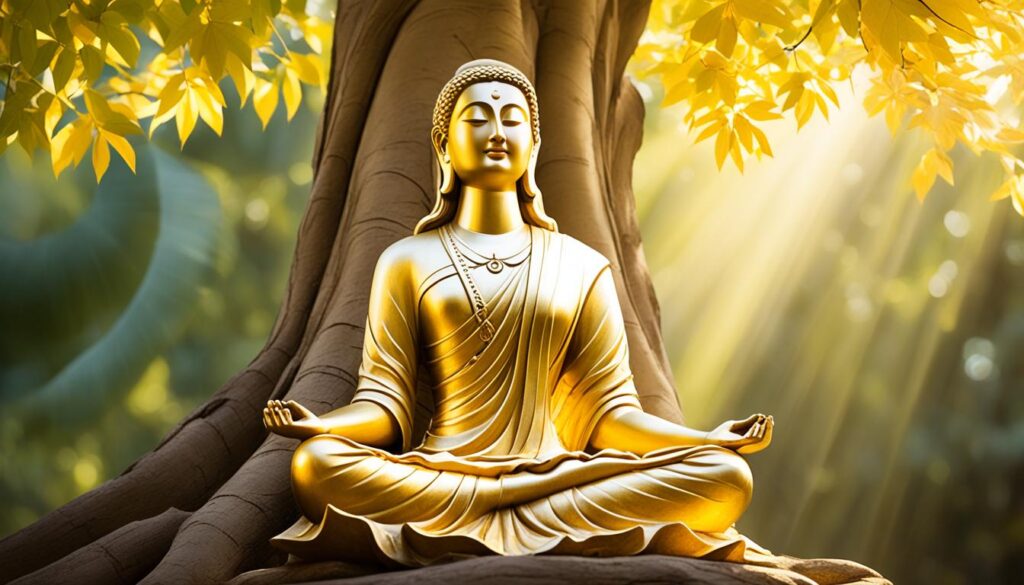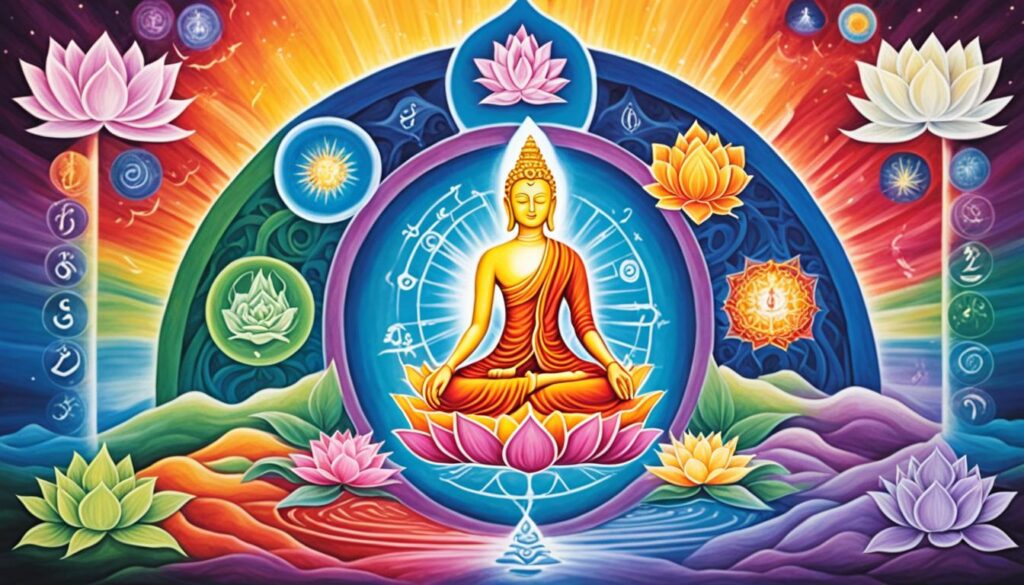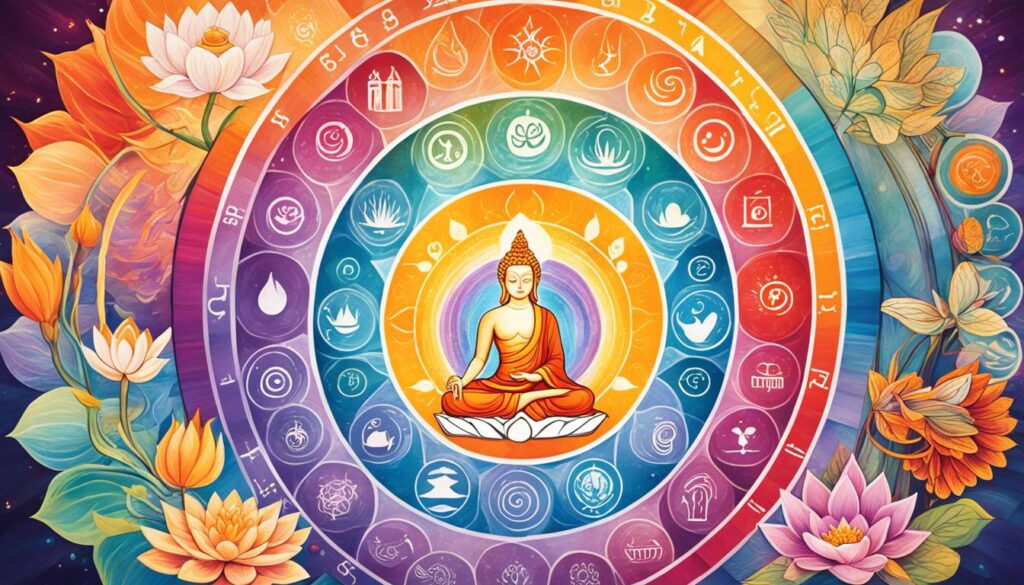“Just as a flower does not pick and choose who can enjoy its fragrance, true compassion and wisdom are boundless.”
Buddhism, with its rich history and profound teachings, offers a path of self-discovery and personal transformation. Its core beliefs and principles revolve around compassion, mindfulness, and the pursuit of wisdom. By exploring the beliefs of Buddhism, you can embark on a spiritual journey that leads to a more meaningful and fulfilling life.
Key Takeaways:
- Buddhism is a major global religion with a complex system of beliefs.
- The Four Noble Truths and the Eightfold Path are the foundation of Buddhist teachings.
- Karma and the cycle of rebirth play a significant role in Buddhism.
- Buddhism has various schools or traditions that offer different paths to enlightenment.
- By embracing the beliefs of Buddhism, you can find guidance on your own spiritual journey towards personal transformation and societal harmony.
The Life and Teachings of Siddhartha Gautama
Siddhartha Gautama, also known as the Buddha, was the founder of Buddhism. Born as a prince, he lived a life of luxury and abundance until he witnessed the harsh realities of old age, sickness, and death. These profound experiences compelled him to renounce his princely title and embark on a spiritual quest for truth and enlightenment.
Through years of deep meditation and rigorous self-discipline, Gautama achieved enlightenment and became known as the Buddha, which means “the Enlightened One”. His teachings and insights have since guided millions of people on their spiritual journey towards liberation from suffering.
The Middle Way: Finding Balance and Enlightenment
The core teaching of Siddhartha Gautama is the Middle Way, a path that advocates for balance and moderation in all aspects of life. It is a rejection of extreme asceticism and excessive indulgence, recognizing that true enlightenment lies in finding a harmonious and balanced approach.
The Middle Way encourages individuals to cultivate mindfulness, compassion, and self-awareness while navigating the challenges and temptations of the world. By following this path, one can attain liberation from suffering and achieve a state of profound peace and wisdom.

Through his teachings, Siddhartha Gautama emphasized the importance of self-reflection, ethical conduct, and the development of insight into the nature of reality. He taught that enlightenment is not beyond reach and that anyone, regardless of their background or status, can attain it through diligent practice and a sincere desire for spiritual growth.
| Buddha’s Teachings | Description |
|---|---|
| The Four Noble Truths | The existence of suffering, its cause, its end, and the path to its end. |
| The Noble Eightfold Path | A set of eight principles that guide individuals towards the end of suffering and the attainment of enlightenment. |
| Karma and Rebirth | The law of cause and effect that influences one’s actions, future lives, and the cycle of rebirth. |
| The Middle Way | The path of balance and moderation to attain enlightenment. |
By incorporating the teachings of Siddhartha Gautama, individuals can cultivate inner peace, compassion, and wisdom, leading to a transformation of themselves and the world around them.
The Four Noble Truths and the Eightfold Path
The Four Noble Truths are the foundation of Buddhist teachings. They explain the existence of suffering, the cause of suffering, the end of suffering, and the path that leads to the end of suffering. Buddhism recognizes that worldly pleasures are impermanent and unsatisfactory, urging individuals to detach themselves from desires and attachments. By understanding the Four Noble Truths, one can gain insight into the nature of suffering and discover the path to liberation.
According to Buddhist philosophy, the cause of suffering is a combination of desire and ignorance. The attachment to desires creates a cycle of craving and dissatisfaction, leading to suffering. Ignorance creates a lack of understanding about the true nature of reality. By recognizing and overcoming these causes, individuals can work towards the end of suffering.
The end of suffering is attainable through the practice of the Noble Eightfold Path. This path consists of eight interconnected factors that guide individuals towards liberation. They include:
- Right Understanding
- Right Thought
- Right Speech
- Right Action
- Right Livelihood
- Right Effort
- Right Mindfulness
- Right Concentration
By cultivating these qualities in one’s thoughts, speech, and actions, individuals can develop wisdom, ethical conduct, and mental discipline. The Noble Eightfold Path provides a holistic framework for personal development, allowing individuals to transform their lives and find freedom from suffering.

The Eight Steps of the Noble Eightfold Path
| Step | Description |
|---|---|
| 1. Right Understanding | Developing a deep understanding of the Four Noble Truths and the nature of reality. |
| 2. Right Thought | Cultivating thoughts of goodwill, compassion, and non-harming. |
| 3. Right Speech | Using truthful, kind, and beneficial speech. |
| 4. Right Action | Engaging in ethical conduct and avoiding harmful actions. |
| 5. Right Livelihood | Choosing a livelihood that is aligned with moral principles and avoids harm to others. |
| 6. Right Effort | Making a sustained effort to cultivate wholesome qualities and overcome unwholesome ones. |
| 7. Right Mindfulness | Developing a clear awareness of the present moment and cultivating mindfulness in all activities. |
| 8. Right Concentration | Cultivating focused and unified states of mind through meditation. |
Karma and the Cycle of Rebirth
Karma is a central concept in Buddhism that embodies the idea of cause and effect. It is the understanding that our actions, whether good or bad, have consequences not only in this life but also in future lives. In essence, karma determines the trajectory of our existence and the experiences we encounter along the way.
In the Buddhist belief system, good actions lead to positive outcomes, while bad actions result in suffering. This understanding of karma encourages individuals to cultivate virtuous behavior and refrain from harmful actions, as doing so ensures a more favorable future.
The cycle of rebirth, known as samsara, is deeply intertwined with the concept of karma. It is believed that when we die, our consciousness continues and is reborn in a new form, based on the karma we have accumulated. This continuous cycle perpetuates until one attains enlightenment and breaks free from the cycle of rebirth.
Within the cycle of rebirth, there are six realms into which beings can be reborn. These realms are divided into three favorable realms and three unfortunate realms. The favorable realms include the realms of demigods, gods, and humans, where individuals experience relatively positive conditions. On the other hand, the unfortunate realms consist of animals, ghosts, and hell, where suffering and unfavorable conditions prevail.
Of these realms, human birth is regarded as precious and highly favorable. Human existence provides the opportunity to work towards enlightenment, or nirvana, and escape the cycle of rebirth. It is considered a critical opportunity for individuals to break free from suffering and achieve ultimate liberation.
Here is a visual representation of the realms within the cycle of rebirth:
| Favorable Realms | Unfortunate Realms |
|---|---|
| Demigods | Animals |
| Gods | Ghosts |
| Humans | Hell |
The cycle of rebirth, influenced by karma, serves as a reminder of the importance of our actions and their consequences. By practicing good deeds, cultivating compassion, and striving for enlightenment, we can shape our future existence and ultimately transcend the cycle of rebirth.

Schools of Buddhism
The rich and diverse world of Buddhism has given rise to various schools or traditions over time. Each school has its own unique practices and interpretations, yet they all share the common objective of liberation from suffering. Let’s explore three prominent schools of Buddhism: Mahayana Buddhism, Theravada Buddhism, and Vajrayana Buddhism.
Mahayana Buddhism
Mahayana Buddhism is widely practiced in China, Taiwan, Japan, and South Korea. This school places great emphasis on compassion and the role of bodhisattvas, enlightened beings who guide others on the path to enlightenment. Bodhisattvas are compassionate figures who delay their own nirvana to help liberate other beings, embodying the ideals of selflessness and altruism. The goal of Mahayana Buddhism is to attain enlightenment not only for oneself but also for the benefit of all sentient beings.
Theravada Buddhism
Theravada Buddhism is prevalent in Sri Lanka, Cambodia, Thailand, Laos, and Burma. This school focuses on monasticism and meditation as the primary means to achieve enlightenment. Monks and nuns dedicate their lives to strict observance of ethical guidelines, meditation practices, and the study of Buddhist scriptures. Theravada Buddhism emphasizes the individual’s path to liberation, with the ultimate goal of reaching nirvana through self-discipline, mindfulness, and the eradication of desire and ignorance.
Vajrayana Buddhism
Vajrayana Buddhism is primarily practiced in Tibet, Nepal, Bhutan, and Mongolia. It is known as the “Diamond Vehicle” and offers expedited methods for attaining enlightenment. Vajrayana practitioners utilize various meditation techniques, ritual practices, and mantra recitation to transform ordinary experiences into paths of awakening. Central to Vajrayana Buddhism are the empowerment and guidance of a qualified teacher, known as a guru, who imparts secret teachings and initiations to accelerate spiritual progress.
Each school of Buddhism provides a unique path to spiritual awakening, catering to the diverse needs and aspirations of individuals. This diversity reflects the profound richness and adaptability of the Buddhist tradition.

| School | Key Features | Main Regions |
|---|---|---|
| Mahayana Buddhism | Emphasis on compassion and role of bodhisattvas | China, Taiwan, Japan, South Korea |
| Theravada Buddhism | Focus on monasticism and meditation | Sri Lanka, Cambodia, Thailand, Laos, Burma |
| Vajrayana Buddhism | Expedited methods for attaining enlightenment | Tibet, Nepal, Bhutan, Mongolia |
Conclusion
Buddhism offers profound insights and teachings that can guide you on a spiritual journey towards personal transformation and enlightenment. By embracing the core beliefs of Buddhism, centered around mindfulness, compassion, and the pursuit of wisdom, you can embark on a path of self-discovery, self-improvement, and spiritual growth.
These teachings have the potential to bring harmony not only to your personal life but also to society as a whole. The principles of Buddhism encourage individuals to cultivate compassion, understanding, and empathy, fostering societal harmony and peaceful coexistence. As you delve deeper into the teachings of Buddhism, you will find profound connections between your own well-being and the well-being of others.
Your spiritual journey in Buddhism may lead you to a greater understanding of yourself and the world around you. The practice of mindfulness helps you cultivate awareness and live in the present moment, enhancing your overall sense of fulfillment and contentment. By embodying compassion, you can develop deeper connections with others and contribute to a more compassionate and harmonious society.
Explore the beliefs and teachings of Buddhism, and allow them to inspire and guide you towards a more meaningful and fulfilling life. Let Buddhism be a source of wisdom and inspiration as you navigate the complexities of existence, empower your personal transformation, and contribute to the creation of a more compassionate and harmonious world.
FAQ
What are the core beliefs of Buddhism?
The core beliefs of Buddhism revolve around the Four Noble Truths, which address the existence of suffering, the cause of suffering, the end of suffering, and the path to end suffering.
What is the Middle Way?
The Middle Way is the path emphasized by Buddha, which advocates for avoiding extreme asceticism and excessive indulgence to attain enlightenment and liberation from suffering.
What are the Four Noble Truths and the Eightfold Path?
The Four Noble Truths explain the existence of suffering, the cause of suffering (desire and ignorance), the end of suffering, and the path that leads to the end of suffering. The Eightfold Path consists of right understanding, right thought, right speech, right action, right livelihood, right effort, right mindfulness, and right concentration. Following this path cultivates wisdom and ethical conduct to attain liberation from suffering.
What is karma?
Karma is the law of cause and effect in Buddhism. It posits that a person’s actions, good or bad, have consequences in this life and future lives. Good actions lead to happiness, while bad actions lead to suffering.
How does the cycle of rebirth work in Buddhism?
The cycle of rebirth, known as samsara, is influenced by karma. Beings can be reborn in six realms, including the three fortunate realms (demigods, gods, and humans) and the three unfortunate realms (animals, ghosts, and hell). Human birth is considered precious as it offers the opportunity to attain enlightenment and escape the cycle of rebirth.
What are the different schools of Buddhism?
Buddhism has various schools, including Mahayana Buddhism, Theravada Buddhism, and Vajrayana Buddhism. Mahayana Buddhism emphasizes compassion and the role of bodhisattvas in guiding others to enlightenment. Theravada Buddhism focuses on monasticism and meditation. Vajrayana Buddhism offers expedited methods for attaining enlightenment.
How can Buddhism guide personal transformation and societal harmony?
By embracing the core beliefs of Buddhism, individuals can embark on a path of self-discovery, self-improvement, and spiritual growth. Buddhism’s teachings centered around mindfulness, compassion, and wisdom have the potential to bring harmony to personal lives and society as a whole.

